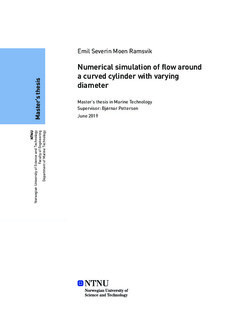| dc.contributor.advisor | Pettersen, Bjørnar | |
| dc.contributor.advisor | Jiang, Fengjian | |
| dc.contributor.author | Ramsvik, Emil Severin | |
| dc.date.accessioned | 2019-10-23T14:02:07Z | |
| dc.date.available | 2019-10-23T14:02:07Z | |
| dc.date.issued | 2019 | |
| dc.identifier.uri | http://hdl.handle.net/11250/2624005 | |
| dc.description.abstract | I denne masteroppgaven utforskes strømning rundt en konkav buet sylinder med en endring i diameter. Studien bruker direkte numerisk simulering for å løse Navier-Stokes ligningene uten bruk av turbulensmodellering. Fokuset på denne oppgaven er å undersøke hvordan plasseringen av endringen i diameter, eller trinnet påvirker væskestrømmen rundt geometrien og i kjølvannet.
Ulike geometriske konfigurasjoner ble undersøkt, med trinnets vinkel som hovedparameteren. I tillegg til den konkave sylinderen med en forandring i diameter ble det undersøkt strøming rundt rette sylindere med et trinn både normalt på og parallelt med strømningsretningen.
De rette sylinderkonfigurasjonene viste forskjellige virvelstrukturer som dannes. Den horisontale sylinderen hadde resirkuleringssoner foran trinnet, og den vertikale sylinderen hadde kryss- og kantvirvler rundt trinnet.
Uniform strømning ved et Reynolds tall på 600 viste at påvirkning av trinnet har stor innvirkning på kjølvannet. Krumningen fremkaller en vertikal strøm, som enten kan forsterkes eller reduseres av trinnet. På kanten av trinnet var det en nedgang i trykket som skaper en lavtrykksone som enten kunne motvirke eller øke den vertikale strømningen fra trinnet.
Parameterundersøkelsen viste at vinklingen av trinnet kunne grupperes i tre kategorier. Den første inneholdt vinkler fra et trinn som er normalt til den innkommende strømmen til 45 degrees vinkel på den innkommende strømmen. Denne gruppen inneholdt resirkuleringssoner både foran trinnet og bak kanten av trinnet. Den første gruppen hadde lignende virvelstrukturer med den rette sylinderen i parallell strømning.
Den andre gruppen inneholdt vinklinger av trinnet på 45 grader og 60 grader. Strømningsfeltet rundt disse to konfigurasjonene skiller seg fra alle andre simuleringer.
Den tredje gruppen inneholder konfigurasjoner med vinklinger av trinnet over 60 grader. Virvelavløsning skjer fra både den lille og store sylinderen. Denne gruppen har lignende virvelstrukturer som den rette vertikale sylinderen med en forandring i diameter. | |
| dc.description.abstract | In this master thesis, the flow around a concave curved cylinder with a change in diameter is presented. The study uses Direct Numerical Simulation to solve the Navier-Stokes equations without the use of turbulence modeling. The focus of this thesis is to investigate how the position of the change in diameter, or the step affects the fluid flow around the geometry and in the wake.
Different geometrical configurations were investigated, with the angle of the step being the main parameter investigated. In addition to the concave cylinder with a change in step, straight cylinders with a step both normal to and parallel to the flow direction was investigated.
The straight cylinder configurations showed distinct vortex structures forming. The horizontal cylinder had recirculation zones in front of the step and the vertical cylinder had junction and edge vortices around the step.
Uniform flow at a Reynolds number of 600 showed that the influence of the step has a large impact on the wake. The curvature induces a vertical flow, which can either be enhanced or reduced by the step.
At the edge of the step, there was a decrease in pressure creating a suction zone which could either counteract or enhance the vertical flow from the step.
The parameter study showed that the step angles could be grouped into three categories. The first contained angles from a step normal to the incoming flow to a45◦angle to the incoming flow. This group contained recirculation zones in front of and behind the edge of the step. The first group had similar vortex structures with the straight cylinder in parallel flow. The second group contained step angles between 45 degrees and 60 degrees. The flow field around those two configurations differed from all other simulations. The third group contains configurations with step angles above 60 degrees. Vortex shedding occurs from both the small and large diameter cylinder. This group has similar vortex structures as the straight vertical cylinder with a change in step. | |
| dc.language | eng | |
| dc.publisher | NTNU | |
| dc.title | Numerisk Simulering av strømning rundt en kurvet sylinder med varierende diameter | |
| dc.type | Master thesis | |
